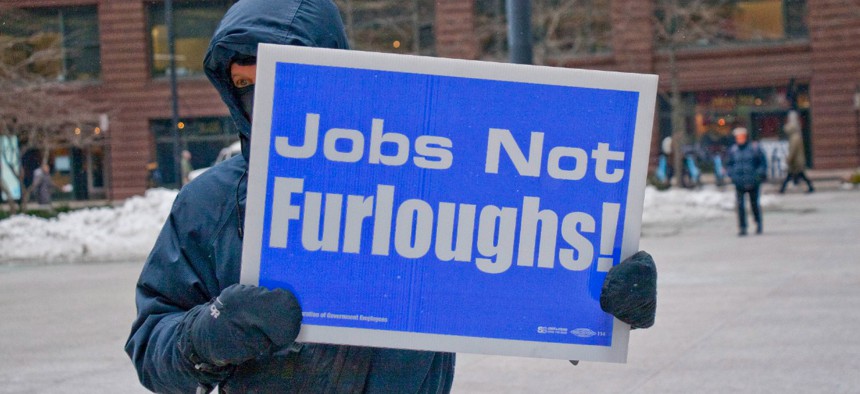
American Federation of Government Employees members protest a government shutdown in January 2019. Flickr user Charles Edward Miller
Biden Administration Appears to Take a Furlough Approach Similar to Trump's as Shutdown Nears
The White House has yet to say if it will employ the same drastic tactics to keep some agencies fully operational during a funding lapse.
Federal agencies are preparing for a government shutdown later this week, and those that have revealed their contingency plans are following a path similar to the one taken under the Trump administration.
Only a fraction of federal agencies have updated their shutdown plans in recent months, but those that have unveiled new outlines have barely adjusted them from previous iterations. That is despite President Trump taking an unusual approach during the shutdowns that took place under his administration, when he gave agencies wide discretion in using various funds to avoid employee furloughs and remain operational. Absent congressional action, federal offices will be forced to close their doors and send at least some workers home without immediate pay on Friday.
President Biden’s White House has not yet unveiled if it will take a similar overall approach to Trump’s, which instructed agencies to use “carry-forward funding” and greater “transfer authority” to minimize the impact of the shutdowns. That led to agencies such as the Environmental Protection Agency, Energy Department and Federal Communications Commission keeping their employees at work even after appropriations lapsed.
Some agencies have provided a glimpse into their shutdown approaches through their public contingency plans. The Justice Department, for example, said in August it would furlough about 15% of its workforce during a shutdown in fiscal 2022. By comparison, Justice sent home 17% and 16% of employees during shutdowns that occurred in 2018. NASA plans to furlough 92% of its workforce, compared to 95% in 2018.
The Treasury Department would only send home about 42% of its workforce, which aligns with the Trump administration’s final approach at the department. During a short shutdown in early 2018, Treasury sent home 83% of its workforce. During the record-setting funding lapse in late 2018 and early 2019, however, the Internal Revenue Service—which employs 92% of Treasury employees—recalled a significant portion of its workforce to prepare for tax season. IRS said earlier this month it would furlough just 42% of its workforce during an October shutdown.
Agencies can deem certain employees “exempted” or “excepted” from furloughs during a shutdown, typically because they are funded through means other than annual appropriations or their work is necessary to protect life or property. The Trump administration accused its predecessors of “weaponizing” shutdowns to maximize their impact for political purposes. It decided, for example, to keep many national parks open during the shutdowns on its watch.
Jenny Anzelmo-Sarles, a spokesperson for the National Park Service, said the agency has not yet decided if it will take the same approach.
“We are hopeful that a lapse in appropriations will not occur but consistent with guidance from [the Office of Management and Budget] we are reviewing our contingency plan,” she said. “Determinations about specific operations and programs have not been made.”
An EPA spokesman referred questions to OMB, which did not respond to a request for comment.
The Government Accountability Office, which enforces the Anti-Deficiency Act, the law that governs federal spending during shutdowns, ultimately found the Trump administration acted unlawfully during the 2018-2019 funding lapse. GAO said the Interior Department violated the law when it used recreation fees collected by the National Park Service to keep parks open and continue services such as trash collection and restroom maintenance. It also faulted the Agriculture Department for disbursing Supplemental Nutrition Assistance Program benefits early during the shutdown.
The Trump administration's decisions tore "at the very fabric of Congress’s constitutional power of the purse,” said GAO, which threatened fines and imprisonment for officials who acted similarly in the future. An OMB spokesperson at the time said Trump directed agencies to make the shutdown "as painless as possible" and called GAO's findings "absurd and heartless."
Senate Republicans on Monday blocked a stopgap spending bill that would have kept agencies funded through Dec. 3, citing a provision that would have suspended the nation’s borrowing limit for 15 months. They have indicated they would support a continuing resolution that did not address the debt ceiling, though Democratic leaders have yet to announce their plan to avoid a shutdown. For the first time, all federal employees—those furloughed and those excepted or exempted—would enter a shutdown with guaranteed back pay once agencies reopen their doors.
(Image via Flickr user Charles Edward Miller)
NEXT STORY: Best Dates to Retire 2022







